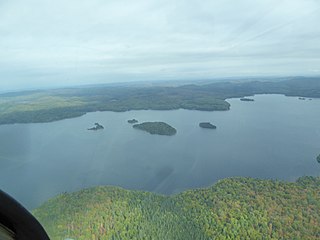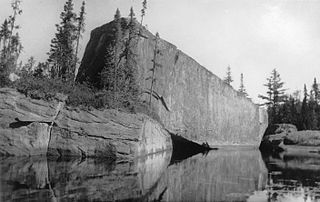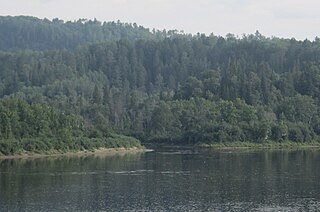
La Tuque is a city located in north-central Quebec, Canada, on the Saint-Maurice River, between Trois-Rivières and Chambord. The population was 11,129 at the 2021 Canadian census, most of which live within the urban area. At over 28,000 km2 (11,000 sq mi), it is the largest city in Canada by area.

Mékinac is a regional county municipality (RCM) of 5,607 km² located in the administrative region of Mauricie, along the Saint-Maurice River, which also crosses the RCM from one end to the other, and the Matawin River, a tributary of the Saint-Maurice. Located in the province of Quebec, Canada.

The Saint-Maurice River, or the Saint-Maurice, is one of the main tributaries of the St. Lawrence River after the Ottawa and Saguenay rivers, this large river, which drains an area of 42,735 km², touches the Lake Saint John watershed to the north, the Nottaway River watershed – a major tributary of James Bay – to the northwest, and the southwestern tributaries of the Ottawa River. The St. Maurice River is located on the north shore of the St. Lawrence River in Quebec, Canada.
Lake Manouane is a lake in central Quebec, Canada. It is just north-east of Kempt Lake, mostly within the boundaries of the City of La Tuque. It should not be confused with more northerly Lake Manouane in the Peribonka River watershed.

The Kempt Lake is located in the unorganized territory of Lac-Matawin, Quebec in the MRC Matawinie, in the administrative region of Lanaudière, in Quebec, in Canada. This reservoir is located on the route of the Manouane River in northern Rouge-Matawin Wildlife Reserve.
The Batiscanie is the watershed of the Batiscan River, located in the centre of the province of Quebec, Canada, covering 4690 km² on the North Shore of the St. Lawrence River. The area covered by the Batiscanie is 53% in the administrative région of Mauricie and 47% in the administrative region of the Capitale-Nationale.

Lac-Normand is an unorganized territory in the Mauricie region of Quebec, Canada, part of the Mékinac Regional County Municipality.

The Wayagamac Lake is located in the city of La Tuque in La Tuque, in Mauricie, in Quebec, in Canada. Until 2006, the territory of the lake was part of the former unorganized territory of Petit-Lac-Wayagamac, before being merged to the La Tuque. The area of the lake is administered by the Zec de la Bessonne.

The Wessonneau River flows north-east in the Mekinac Regional County Municipality in Mauricie, in Quebec, in Canada, on the west bank of the Saint-Maurice River. The watershed of the river is administered by:

The Rivière aux Rats flows south-east for about 60 km, in forested areas in La Tuque in Mauricie, in Quebec, in Canada. Its mouth is located at the opposite bank of the “Rivière-aux-Rats” hamlet, which is on the east side of Saint-Maurice River, at 29.5 km south of Downtown La Tuque

The Vermillon River flows in the territory of La Tuque, in Upper-Mauricie, in the administrative region of Mauricie, in Quebec, Canada.
Lake Hackett is located in Hackett (township) in the unorganized territory of Lac-Masketsi, in the Mekinac Regional County Municipality, in the administrative region of Mauricie, in Quebec, in Canada.
The Rivière aux eaux mortes flows entirely in forest areas in two territories Quebec, in Canada:
The Zec Kiskissink is a "zone d'exploitation contrôlée" (zec), located in the administrative region of the Mauricie, the Capitale-Nationale and Saguenay-Lac-Saint-Jean, in Quebec, in Canada. This wild territory, used for recreative activities is managed by the "Sacerf Macousine Association".
The ZEC Wessonneau is a "zone d'exploitation contrôlée" (ZEC), located on the west bank of the Saint-Maurice River, in the La Tuque, in the region the Mauricie, in Quebec (Canada). This public hunting and fishing area is managed by the "Association chasse et pêche Fléchée Inc".

The ZEC Chapeau de Paille is a "zone d'exploitation contrôlée" (zec), located in the Mekinac Regional County Municipality, in administrative region of Mauricie, in Quebec (Canada).
The Zec Ménokéosawin is a "zone d'exploitation contrôlée", located in the region of Mauricie, in Quebec, Canada. This public hunting and fishing area is managed by the "Association de chasse-pêche de la rivière Bostonnais Nord", a non-profit organization.
The Windigo River runs in the unorganized territory of Lac-Ashuapmushuan, Quebec and in the territory of La Tuque, in Mauricie, in Quebec, in Canada.
The Petit lac Wayagamac is located in the city of La Tuque, in Mauricie, in Quebec, in Canada. Until 2006, the territory of this lake was part of the former unorganized territory of Petit-Lac-Wayagamac, before being merged with La Tuque. The territory of the lake is controlled by the Zec de la Bessonne.
The rivière Wessonneau du Milieu is a tributary of the Wessonneau North River, in the town of La Tuque, in the region of Mauricie, in the province of Quebec, in Canada.










